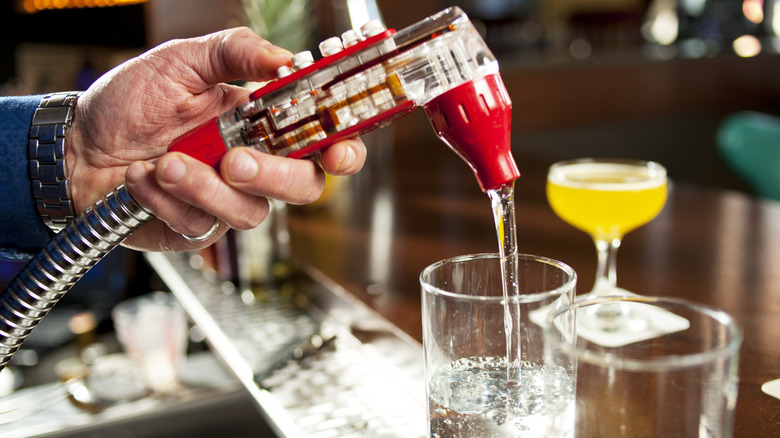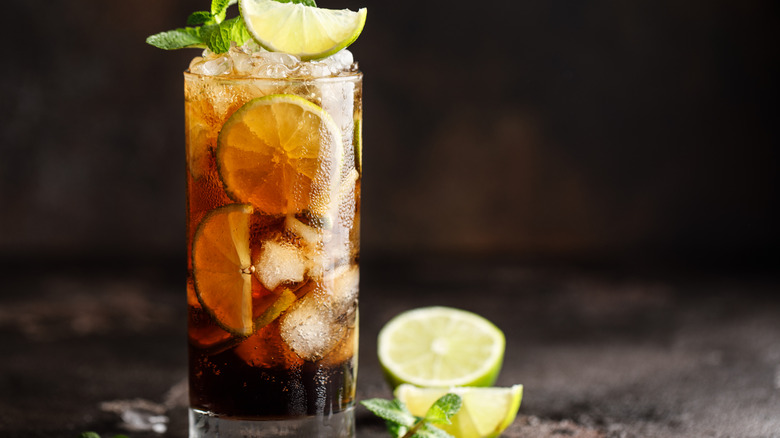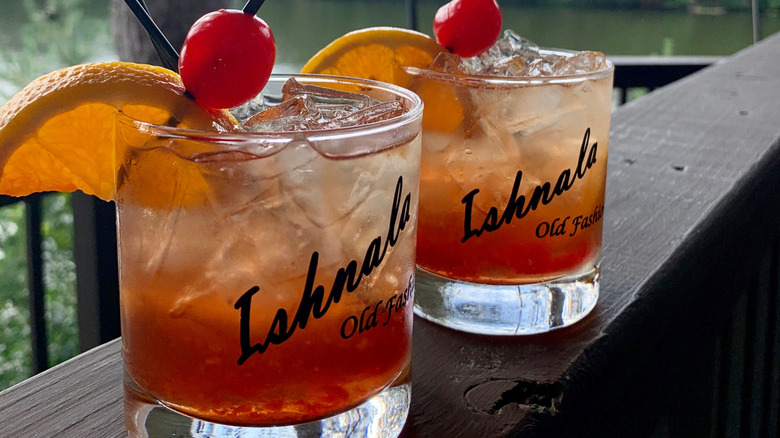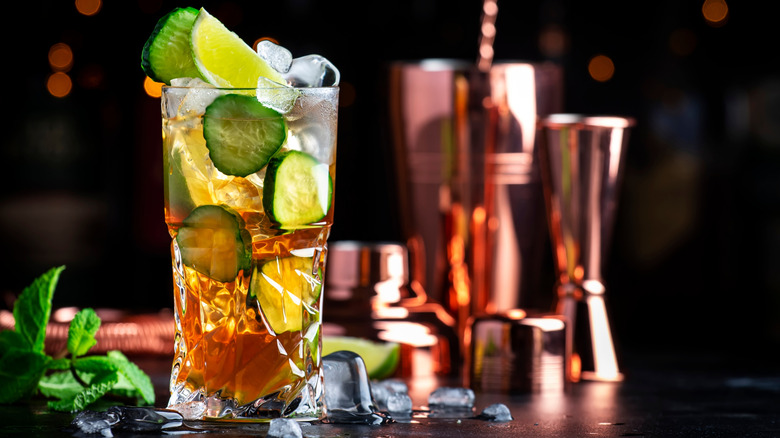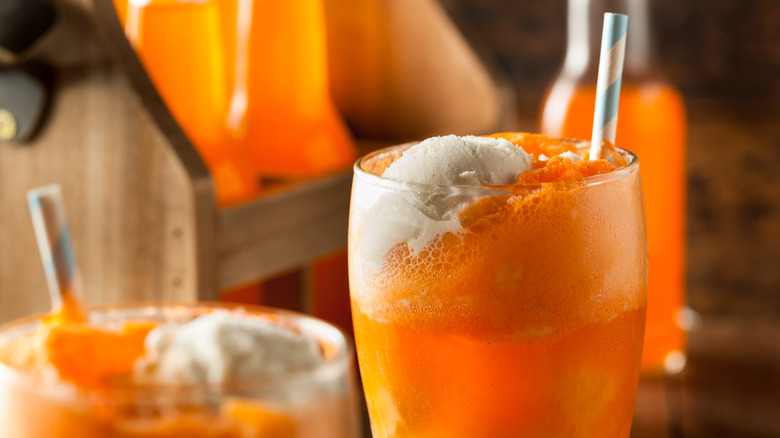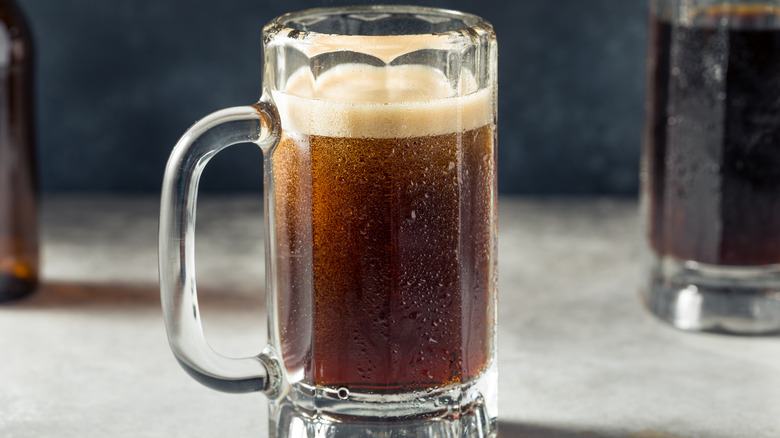5 Soda And Liquor Pairings To Try In Your Next Drink
We may receive a commission on purchases made from links.
There's a good chance that the very first mixed drinks many of us ever knocked back consisted of soda and booze be it a rum and Coke, a Jack and Coke, a vodka and Sprite, or whatever kind of alcohol was on hand combined with any soda that happened to be in the fridge. Sodas tend to be super sweet, which makes them the perfect vehicle for camouflaging booze's more bitter and astringent flavor notes, and as such, they may have helped countless newbie drinkers learn to acquire a taste for the harder stuff.
Young people these days may be more apt to take their soda sans booze. Health-conscious Gen Z, who are on track to be the soberest generation in decades, have embraced dirty soda bars where you can create your own mocktails out of flavored syrups, coffee creamers, and sodas. This doesn't mean, though, that soda no longer has a part to play if you prefer to go old-school and get buzzed off booze instead of (or rather, in addition to) sugar. Countless cocktails, ranging from the simple "plus ones" described above to more complex concoctions calling for multiple ingredients, still use soda as a standard mixer.
Cola rum
Cola, whether it be Coke, Diet Coke, Pepsi, or RC Cola, is a popular and surprisingly versatile drink mixer. We've already mentioned two drinks in which it figures prominently, but another one of its greatest hits is the Cuba Libre, which is essentially a rum and Coke plus a squeeze of lime. This third ingredient not only adds a little zing that cuts through the cola's sweetness but turns the beverage from a mixed drink into a cocktail. (Mixed drink = booze plus one mixer; cocktail = booze plus two or more.)
Cola also features in other Latin American drinks such as Chile's piscola (Pisco + cola + bitters), Argentina's Fernet con coca (amaro + cola), and Mexico's batanga (tequila, cola, and lime), as well as being the secret ingredient that adds the tea color and a bit of sweetness to the Long Island Iced Tea. Still, none of these drinks will ever achieve quite the classic status of the simple rum pairing (with or without lime) because cola has some acidity to it and both beverages also have a surprisingly complex and hard-to-dissect blend of flavors. When you add the two together, we're not quite sure what happens, but the whole is greater than the sum of its parts. (Not to mention a lot better tasting than colabier, the questionable German concoction consisting of cola + beer.)
Lemon-lime soda brandy
Sprite may be the most popular lemon-lime soda, but 7-Up (which tastes nearly identical, to be honest) has a namesake drink: Seven and Seven, made with this soda and Seagram's 7 blended whiskey. (Other lemon-lime sodas and blended whiskeys also, work, though.) The drink may be simple, but whiskey adds some complexity to the soda without overwhelming the citrusy sweetness. Lemon-lime soda also features in several cocktail makeovers, adding sweetness to rum-based mojitos and bringing sugar and fizz to tequila sunrises and margaritas. For our money, though, the best liquor to pair with lemon-lime soda is one you may not have thought of unless you're from Wisconsin: brandy.
In the other 49 states (and quite possibly the rest of the world), an old fashioned is typically made with bourbon or rye, simple syrup, and water. Bor-ing. A Wisconsin brandy old fashioned, however, is sweet, sparkly, and comes in a number of varieties. Sour is made with grapefruit soda (usually Squirt, since Wisconsin's not really Ting territory), but sweet means the mixer is Sprite, 7-Up, or another lemon-lime soda. Brandy itself is on the sweet side, but a dash of bitters tempers the sugar just enough to make for a well-balanced drink. If you want to cut down on the sugar but you're no fan of grapefruit soda, there's also a third option: Press uses a 50-50 combo of lemon-lime soda and plain seltzer.
Ginger ale gin
While ginger beer stars in a more prominent cocktail — the retro-trendy Moscow Mule — ginger ale seems to be a more mainstream soda. It, too, makes a decent addition to any home bar setup since it can also be paired with just about any liquor to make a simple mixed drink. While it tastes okay with rum, whiskey, and even tequila, our top pick for this mixer is gin (and no, not entirely due to the alliteration). The gin buck, which is gin + ginger ale with a squeeze of citrus, is a fine old drink that's been around for the better part of a century. It makes a great alternative to a gin and tonic, specifically for people who can't stand the bitter taste of tonic water.
If we can stretch the definition of gin just a bit to include gin-based liqueurs, though, we find ginger ale featuring in yet another classic cocktail: the Pimm's Cup. This drink is made with Pimm's No. 1, which is to gin as Drambuie is to Scotch. In addition to the liqueur and soda, it includes lemon juice and a veritable garden's worth of garnishes. Lemon, orange, mint, strawberry, and even cucumber somehow manage to squeeze into the glass, making the drink look like bubbly summertime sangria. Pimm's Cup is sweet and refreshing, with the Pimm's lending a touch of gin's juniper-rich astringency without making the drink too boozy. This befits its status as the official beverage of Wimbledon, since tennis isn't a sport that goes well with rowdy, drunken crowds.
Orange soda vodka
Orange Crush, which is the oldest brand of orange soda, dates back to 1906, making it younger than ginger ale (1851), cola (1881), or root beer (1876), but more venerable than come-lately lemon-lime which debuted in 1929. In well over a century, however, orange soda doesn't seem to have been used as an ingredient in any popular cocktails (or mixed drinks, for that matter). Still, there are a few not-so-classic orange soda drinks that food bloggers are fond of promoting, and all of them use vodka as the booze of choice. Who are we to argue with the blogosphere? Vodka it is, since this fairly flavorless liquor lets the soda's sugary orange taste remain at the forefront.
At the most basic level, you can simply spike any old orange soda with vodka, but if you want to get fancy, you can use blood orange soda (San Pellegrino is one well-known brand) and add some orange liqueur. If you opt for a flavored vodka like vanilla or orange and add cream or ice cream, you've got yourself an orange creamsicle cocktail. You can also use Orange Crush to make a cocktail of the same name (although Sunkist or Fanta would work just as well). The original cocktail concocted in the '90s at an Ocean City, Maryland bar was made with lemon-lime soda, but since the other ingredients include orange vodka, triple sec, and orange juice, why wouldn't you commit to going all the way with orange soda as well?
Root beer whiskey
Root beer may be one of the oldest flavored sodas still around today, but it, too, doesn't seem to be featured in any classic cocktails. Still, since the best root beer ranks pretty high up there in the pantheon of sodas, we feel it also deserves a booze pairing. As root beer-flavored whiskey is a thing, it stands to reason, then, that root beer pairs well with whiskey in mixed drinks. Bourbon, in particular, makes the perfect root beer partner since both beverages have vanilla notes.
There's even a nickname for root beer + bourbon: Some call it Lynchburg beer, although it helps if your bourbon (or bourbon-adjacent beverage) of choice is Jack Daniels since it's the most famous brand to hail from Lynchburg, Tennessee. (We're assuming the drink isn't named for Lynchburg, Virginia, since this city's best-known export was probably Jerry Falwell and the Moral Majority back in the Reagan era.) Even better than a simple whiskey-root beer pairing is a whiskey root beer float, which is the same thing plus ice cream. If you want to lean into the sweeter side of this dessert drink, you can opt for a flavored whiskey like cinnamon, peanut butter, or caramel. Conversely, you can add some contrast by stirring in a few drops of bitters.
